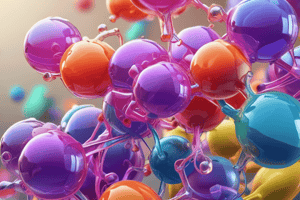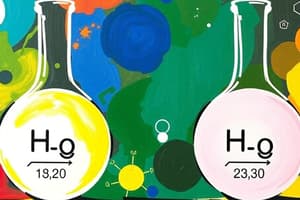Podcast
Questions and Answers
Which of the following statements about the stability of free radicals is true?
Which of the following statements about the stability of free radicals is true?
- 2° > 1° > 3°
- 3° > 2° > 1° (correct)
- 1° > 2° > 3°
- 3° > 1° > 2°
In the reaction of cyclopropane with chlorine, what type of product would be expected?
In the reaction of cyclopropane with chlorine, what type of product would be expected?
- Alkane
- Halide (correct)
- Cycloalkane
- Alkene
What is the correct structure of 1-chloro-2,2-dimethylpropane?
What is the correct structure of 1-chloro-2,2-dimethylpropane?
- CH3-CH2-C(CH3)2-Cl
- Cl-CH2-C(CH3)2-CH3
- CH3-C(CH3)2-CH2-Cl (correct)
- CH3-CH(CH3)-CH2-Cl
Which of the following compounds has the formula $C_nH_{2n}$?
Which of the following compounds has the formula $C_nH_{2n}$?
What feature characterizes an alkene compared to an alkane?
What feature characterizes an alkene compared to an alkane?
Flashcards
Halogenation of Alkanes
Halogenation of Alkanes
A reaction where a halogen atom replaces a hydrogen atom in an alkane.
Free Radical Stability
Free Radical Stability
Tertiary free radicals are more stable than secondary, which are more stable than primary.
Alkenes
Alkenes
Hydrocarbons containing a carbon-carbon double bond.
Alkene Nomenclature
Alkene Nomenclature
Signup and view all the flashcards
Cyclopropane Halogenation
Cyclopropane Halogenation
Signup and view all the flashcards
Study Notes
Halogenation of Alkanes
- Initiation step involves free radical formation
- Propagation step continues the chain reaction
- Termination step ends the reaction
- Stability of free radicals: 3° > 2° > 1°
Halogenation of propane
- Propane reacts with chlorine under UV light
- Forms 1-chloropropane and 2-chloropropane
- Reaction produces a mixture of products
- 2-chloropropane forms more frequently (around 60%)
Halogenation of Neopentane and 2,2-Dimethylpropane
- Neopentane and 2,2-dimethylpropane react with chlorine
- Form 1-chloro-2,2-dimethylpropane preferentially (around 100%)
- This is due to the highly substituted carbon centre
Cyclopropane Halogenation
- Cyclopropane reacts with chlorine under UV light
- Forms halogenated products
Alkenes
- Alkenes are unsaturated hydrocarbons
- Contain a carbon-carbon double bond
- General formula: CnH2n
- Exhibit sp2 hybridization
- Undergo addition reactions
- Representative examples: ethylene, propylene, isobutylene
IUPAC Nomenclature
- Primary/Normal, Iso/Secondary, Neo/Tertiary are prefixes used in nomenclature
- Suffixes determine the type of linkage (e.g., -ane, -ene)
- Numbering begins from the side with the substituent
- Substituents are arranged alphabetically
Vinyl and Allyl Groups
- Vinyl group is a substituent with a carbon-carbon double bond
- Allyl group is a substituent with a double bond adjacent to a methyl group
Studying That Suits You
Use AI to generate personalized quizzes and flashcards to suit your learning preferences.




